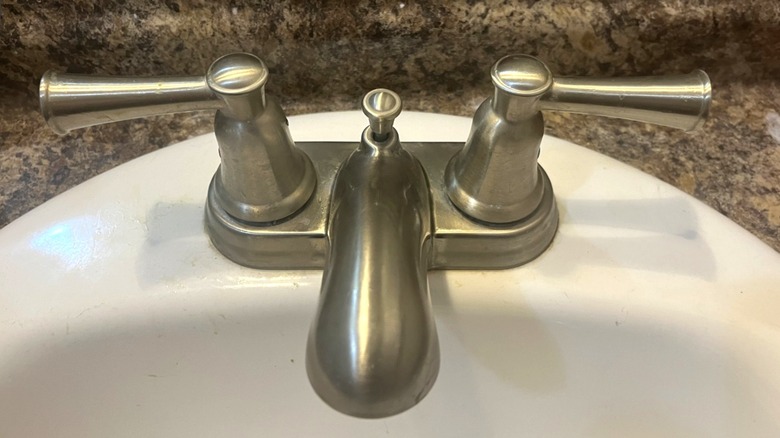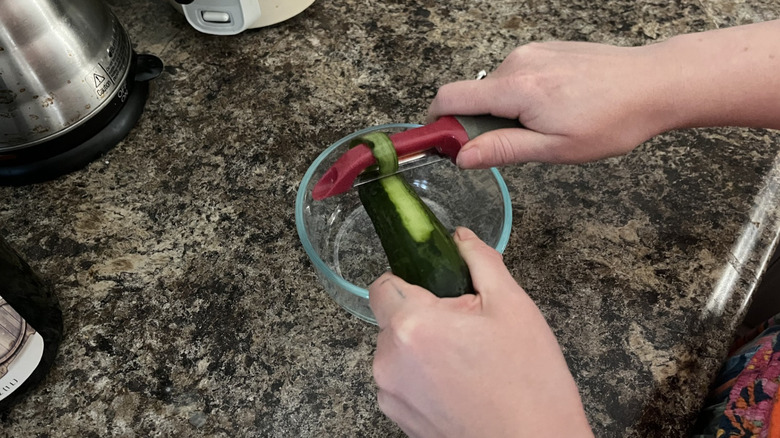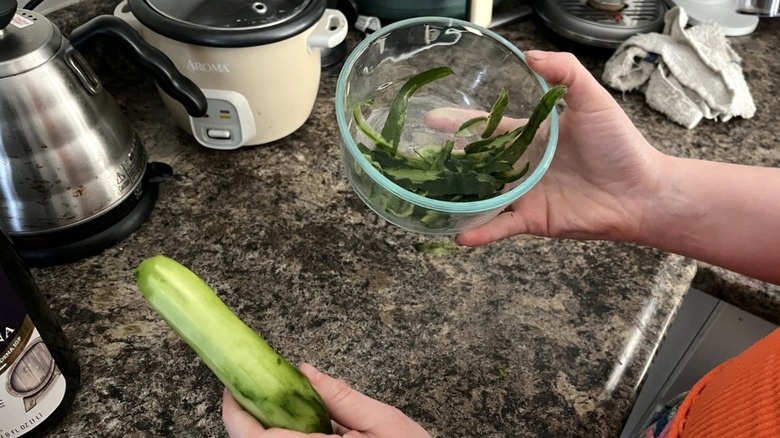We Tried A Time-Saving Bathroom Cleaning Trick That Might Seem Bizarre
Some retro cleaning tips and tricks miss the mark entirely, and it's hard not to laugh when learning about the outlandish ways people attempted to tidy their houses before modern cleaning products and solutions were commonplace. While the days of campy feather dusters and using cola as toilet bowl cleaner may be behind us, there is still some wisdom in the quirky tricks from decades past. That's why, today, we put one particularly bizarre vintage cleaning hack to the test to determine whether it's a clever tip deserving of a resurgence or a complete and utter waste of time. In the hot seat was the old "cucumber on stainless steel" trick. Some people claim that peels from a cucumber can be used to polish smudges from stainless steel and other metal bathroom surfaces; however, I must admit, I was skeptical and wanted to find out just how much truth is behind the idea.
Deep down, I really wanted this hack to work, since cucumbers are inexpensive, free of any harsh or toxic qualities, and frequently stocked in my fridge at home. Supposedly, the peels lift mineral deposits and oils from fingerprints, leaving a clear, smudge-free surface. But I had reservations regarding the overall effectiveness and general cleanliness of this retro cleaning trick, especially since rubbing cucumber peels on a sink faucet won't actually disinfect it. Regardless, I was equipped to get to the bottom of these claims and determine whether using cucumber peels on stainless steel is one of the vintage cleaning rules that deserve a comeback or if this hack is better left in the past.
Gathering materials to put this cucumber cleaner to the test
The list of materials needed to try this hack out at home is alluringly short. To begin, all I needed was a vegetable peeler, a couple of small cucumbers, and a stainless steel bathroom surface in need of a good cleaning, which I admittedly have an abundance of. I grabbed a one-pound bag of Nature Sweet organic mini cucumbers for $3.65 during my weekly Aldi run and enjoyed quite a few before remembering I needed to save a couple to conduct this experiment. Luckily, the amount of peels from the two remaining mini cucumbers seemed like plenty.
Using a cheap peeler I've had in my kitchen drawer for ages, I removed the outer, dark green peels of the cucumbers and set them aside. I tried not to peel too deeply, as I imagine cleaning my sink with the fleshy part of the vegetable might make even more of a mess due to its juiciness. I chose my bathroom sink faucet as a test subject, since the stainless steel was already conveniently covered in dried toothpaste splatter and in desperate need of a refresh. Equipped with my small ramekin of cucumber peels and a skeptical attitude, I was ready to test this vintage cleaning trick myself to determine if it's one of those old-school home hacks we'll use forever.
Using the cucumber peels to shine my sink faucet
I opted not to use gloves when trying this handy hack, since I'm not dealing with any chemicals or toxic ingredients, and the peels are relatively fragile and kind of hard to handle. First, I scooped a handful of the cucumber peelings and simply gave my entire sink faucet a good wiping all over. The dried toothpaste splatters came off pretty much immediately, without the need for applying any pressure or elbow grease. A good bit of moisture came out of the peels, and the wiping motion did remove any smudges or residue on the sink. But after about 30 seconds of wiping, the fistful of peels started to break down and disintegrate in my hand. From that point on, the peels left behind small pieces of pulp and residue that had to be picked off.
The peels were also hard to navigate around the sink while cleaning. Getting into nooks and crannies around the faucet was kind of difficult, since the peels are flimsy and fragile. When I did manage to fit a peel between the sink's faucet and handles, it fell apart instantly and wasn't nimble enough to lift any of the stains on the base of the sink. After I wiped all of the surfaces as best as I could, I had to spend the same amount of time picking off cucumber bits and residue as it took to initially clean the sink with the peels. In total, I spent about five minutes testing this cleaning hack, not including the time it took to peel the cucumbers, which only took a minute or two.
Is it worth trying the cucumber cleaning hack at home?
After letting the sink dry for 30 minutes, I went back in to inspect the final result. Ultimately, I was a bit disappointed. The sink's faucet and handles felt slightly sticky to the touch, so I ended up grabbing a paper towel and disinfectant spray to give the sink a more thorough cleaning and remove any residue left behind from my experiment. While the peels were effective at cleaning off some of the toothpaste stains, they were hard to maneuver and left behind a different mess. Given the result, this is one cleaning hack I wouldn't recommend to others or attempt again in my home. Also, I couldn't find any reliable scientific evidence or reason as to why this would work or why it's a better alternative to other methods of cleaning stainless steel.
All in all, there are better natural ingredients that will leave your bathroom clean without the small frustrations. The cucumber trick created an additional mess that needed cleaning and didn't do anything that a rag or sponge doused with just plain water couldn't do. As mentioned, the vegetable doesn't have any disinfecting qualities, so this trick doesn't actually get surfaces properly clean. If you're concerned about chemicals or want to only use sprays that contain non-toxic materials, you can find alternatives made of safe ingredients like vinegar that are more effective at clearing off smudges and leaving behind a shiny sink that's free of any sticky residue. Overall, after trying this trick, it's safe to say this trend is best left in the past.



